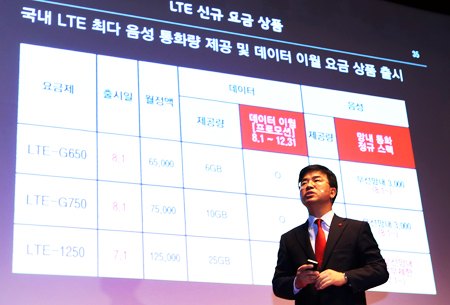KT to commercialize VoLTE

Pyo Hyun-myung, president of KT’s mobile division, speaks Tuesday during a press conference at Olleh Square in Gwanghwamun, Seoul. / Yonhap
Mobile carrier KT announced Tuesday that it will commercialize its voice over long-term evolution (VoLTE) service in October.
Current voice calls are all transmitted through third generation (3G) networks but will use LTE networks once the service starts, allowing better quality and faster connectivity, company officials said.
KT, though last to establish LTE services among the nation’s three mobile carriers, was the fastest in building a nationwide network. It was completed in March and took a mere four months to complete compared to the year for its rivals.
The company is also in an advantageous position with its accumulated knowhow in 3G services such as WiBro to provide uninterrupted connectivity for areas with a poor signal or users on the move. As the No. 1 provider of fixed-line services and 3G prior to the launch of LTE, KT is the most financially stable among its competitors.
“Consumers want high quality images and videos, not just texts.” said Pyo Hyun-myung, president of the company’s mobile business, at a press conference at Olleh Square in Gwanghwamun, Seoul. “We conducted a survey of what consumers wanted and the results indicated more data availability, better call quality and faster connectivity.”
“We have taken these demands into consideration, and will provide the fastest LTE network.”
KT currently has 1.4 million LTE subscribers with a goal to secure 2 million by the end of the year. According to officials, the company has already sold 700,000 LTE handsets this month, and considers its target as virtually achieved.
Pyo also took the opportunity to boast of achieving the highest network speed among carriers, boasting that his company would crush rivals if a speed test was conducted by the Korea Communications Commission or Fair Trade Commission. He also slammed LG Uplus’ demand to share a frequency bandwidth, saying “maybe in the 5G era. It should have asked before starting construction of its LTE network.”
Pyo also announced that it will apply multi-carrier technology, which uses two bandwidths, a 1.8 gigahertz and a 900 megahertz one, to ease data traffic. Carrier aggregation, or combing bandwidths, will be applied from the third quarter next year to further increase connectivity speed.
Multi-carrier technology will start consumer testing on July 23, and spread nationwide starting with the Seoul metropolitan area.
A Rich Communication Suite (RCS), which will allow voice and video calls, short messages, chatting and data transfer simultaneously, is slated to start in October.
The company’s competitors have all revealed outlines of their VoLTE services and given a rough commercialization date. SK Telecom and LG Uplus, first and second in LTE subscriber numbers respectively with 3.5 million and 2.9 million, have both stated that they will start in September. SK said RCS will start in August, while LG did not release a concrete date.
Originally slated for release near the end of the year, the launch date has been pushed forward as mobile carriers face stalling profits from market saturation and competing in new services like free Internet calls.
KT also announced a new fee for the current LTE services in a roll over policy that will allow unused voice call time to automatically carry over to the next month. It is the first among telecommunications companies to do so for LTE.
The main issue surrounding VoLTE is the fee. None of the three firms have revealed the price for the future service, though they estimate it will only be slightly higher than voice calls.
Broadband providers here are betting hard on increased subscribers for LTE networks, which cost billion of won to build, and marketing costs that led them to expect their worst-ever operating profit for the second quarter.
All three carriers are developing multi-carrier technology. Their shared goal is to eventually apply carrier aggregation in which bandwidths will be combined, allowing download speeds of up to 150 megabytes per second. <The Korea Times/Cho Mu-hyun>

























































